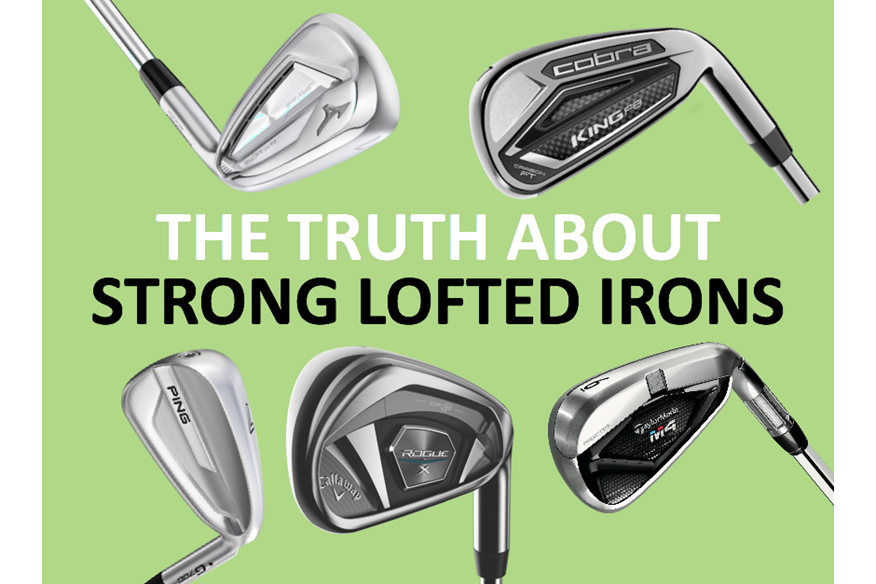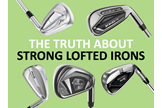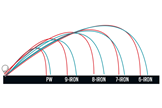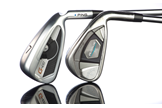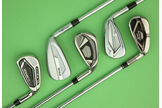The truth about strong lofted irons
Last updated:
Is a 7-iron still a 7-iron when it has the loft of a 5-iron?
Before launch monitors appeared on the scene, iron lofts barely got a look-in when it came to designing, making and marketing the best golf irons. It was pretty much a given that a 7-iron was… well, just a 7-iron. But since launch monitors gave golfers and club fitters the ability to see how far their iron shots carry, the landscape for iron lofts has changed dramatically.
With golfers able to compare a Ping iron against a TaylorMade or Callaway on a launch monitor, manufacturers have made it their business to chase distance. Some pushed so hard they instantly turned a 7-iron into 6-iron (and sometimes even less!) which unwittingly has caused golfers some ball flight issues over the last 10 years.
But it wasn’t until we received so much feedback on our comparative test between Mizuno’s three new JPX919 irons and a blade from 1989 with Sir Nick Faldo, that we realised there’s a real lack of understanding around what strong-lofted irons do, and how they work today.
TESTED: Forged irons ranked by forgiveness
So we’ve made it our business to get you the truth, so you can best decide whether strong lofts should feature your in next set, or not.
How much have lofts really changed?
Quite a lot, actually. Back in the 1990s a 7-iron typically had a 35° loft. The average 7-iron from the 26 sets of forged irons we tested last month was 32°, so 3° less. But if we hone in on the strongest-lofted 7-irons from Ping, TaylorMade and Cobra in 2018 we’d be looking at an average of 29° – that’s a full club-and-a-half stronger than back in the 1990s. Unbelievably, though, they’re not the strongest.
Callaway’s Rogue X (the strongest widely available 7-iron in 2018) incredibly has a 27° loft – the equivalent of a 5-iron back in the ’90s!
TESTED: Titleist Pro V1 vs Mail Order golf balls
A bit about the history of strong lofts
“Loft jacking” as it’s called has been abused over the years, and we reckon some brands would hold their hands up and admit to that. In their defence, like most things you don’t really understand what you’ve created until it’s put into action by thousands of different people.
But in the beginning, make no mistake 7-iron lofts were just replaced by those expected on a 6-iron. It did what engineers wanted, and increased ball speed and carry distance – two factors most golfers look for on a launch monitor. But strong lofts also meant shots launched, landed on a green and span like a club less, which when translated to 6, 5 and 4 irons was less than ideal when hitting approaches.
Shots flew lower, with less spin, making it difficult to stop them on the dancefloor. So even though golfers gained yards, many complained about consistently chipping back onto putting surfaces because their ball flight and descent was so shallow they couldn’t hold the green.
So how do modern strong-lofted irons work?
Strong-lofted irons have come a very long way since those crude, early days. Today there’s much more science behind them than just jacked-up lofts. Our understanding of weight distribution, face flex tech, CG placement and its effect on spin has improved dramatically.
Materials have also improved, and all this adds up to new solutions that help us hit strong-lofted irons higher than ever before. Ping’s director of engineering, Marty Jertson, offers the best explanation of how strong-lofted irons work. Ping’s G400 iron have a COR-EYE structure in the centre, which stiffens the face and forces the extremely thin leading edge of the iron to behave like a hinge.
TESTED: The longest irons of 2018
At impact the ball “hinges” the face backwards – increasing launch without drastically reducing spin. So even though the G400 irons had stronger lofts (0.5°) than the preceding G model, shots actually went 4% higher.
The thinking is a little different when it comes to Ping’s Crossover clubs, where the structure of the top edge hinges, helping catapult shots 20% higher than the previous model. It proves there’s more than one way to skin a cat…
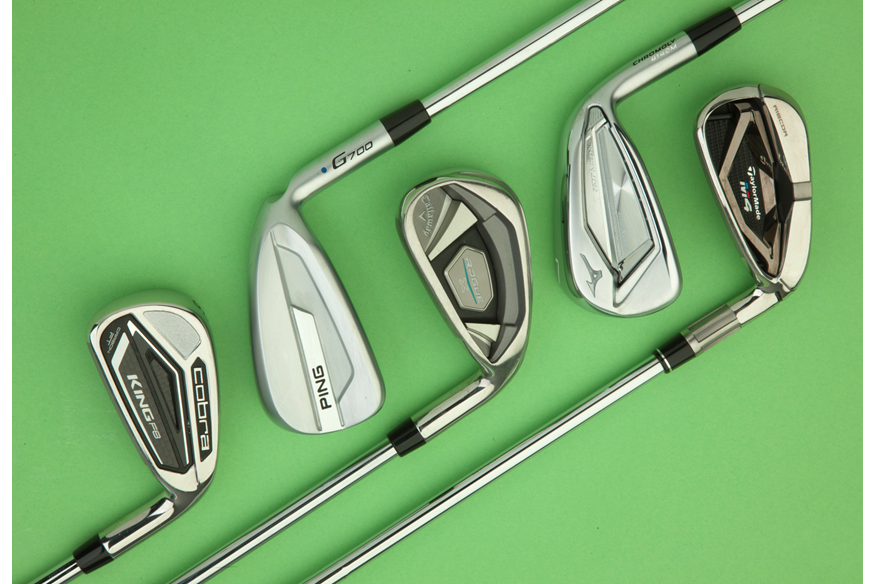
So why don’t all irons have strong lofts?
As golfers get better their technique improves, which tends to mean they hit the ball further. Scratch and plus handicappers are much less likely to worry about adding extra distance to their iron game, so models aimed at them tend to have weaker (standard) lofts – but still stronger than we used in the 1990s and before.
A 16-handicap club golfer who’s likely to buy a set of game-improver irons is much more likely to appreciate gaining six-plus yards on a 7-iron, as long as they can stop shots on the green.
Everything you need to know about shaft weight and why it’s now more important than flex
Modern balls and shafts are part of the mix too
Strong lofts are only part of the equation that today’s golf club engineers use to help you hit their irons further. To make sure shots are flighted properly, lighter shafts are usually used in stronger-lofted models, like the KBS Max in Callaway’s Rogue and TaylorMade M4.
But weight is not the only trick at a club designer’s disposal. They’ll also use softer-tipped shafts (which sometimes can be longer in length, to maximise club speed) which typically flight shots higher, to deliver a towering ball flight.
If you’re looking at playing strong-lofted irons, give some thought to the ball you play, too. There’s no point in counteracting everything the best engineers are doing by playing a low-launching, penetrating golf ball.
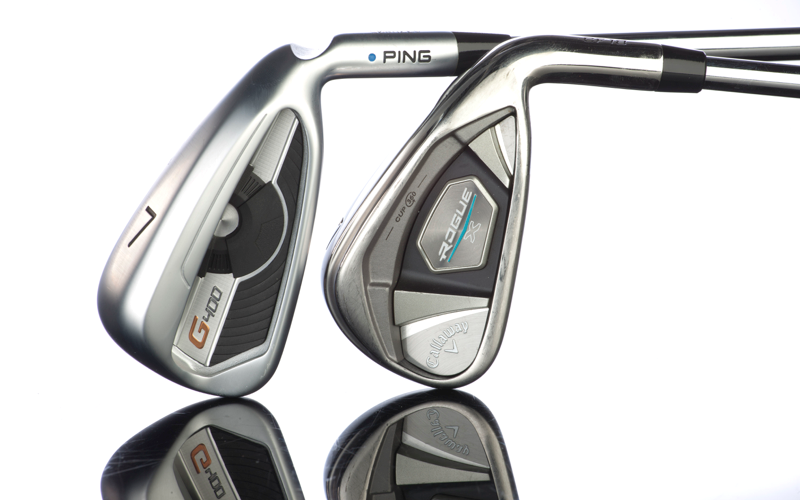
So what difference can a set of strong-lofted irons actually make to your game?
TG Equipment Editor Simon Daddow used a set of custom-fitted Ping G400 irons (which are far from being regular or weak lofts) for a year after their introduction. With them being just about the biggest-selling iron available we thought they were the perfect set to compare against the strongest on the market, the Callaway Rogue X.
His data below shows what happened. We should also point out the Rogue X shafts are half-an-inch longer than the G400, but that’s all part of the distance equation.
|
Key Numbers |
G400(PW) 44.5° | Rogue X(PW) 41° |
G400(9i) 39.5° |
Rogue X(9i) 36° |
G400(8i) 34.5° |
Rogue X(8i) 31.5° |
G400(7i) 30° |
Rogue X(7i) 27° |
G400(6i) 26.5° | Rogue X(6i) 24° |
|
Ball Speed |
80mph |
87mph |
92mph |
95mph |
95mph |
10mph |
102mph |
105mph |
104mph |
107mph |
|
Launch Angle |
27° |
27° |
22° |
21° |
20° |
18° |
17° |
17° |
16° |
16° |
|
Backspin |
6270rpm |
5828rpm |
6551rpm |
6965rpm |
5852rpm |
6323rpm |
6384rpm |
5061rpm |
5016rpm |
4694rpm |
|
Height |
18yds |
22yds |
20yds |
19yds |
19yds |
20yds |
19yds |
21yds |
19yds |
20yds |
|
Descent Angle |
44° |
46° |
44° |
43° |
40° |
41° |
40° |
39° |
37° |
37° |
|
Distance |
105yds |
120yds |
124yds |
132yds |
135yds |
144yds |
143yds |
158yds |
157yds |
166yds |
Tiger’s 2004 Nike Ignite driver vs his 2018 TaylorMade M3
What the launch monitor numbers reveal
Our verdict:
You have to remember Callaway say themselves the Rogue X is an all-out assault on distance and they openly admit the set is not for everyone, but they have completely transformed my iron game in the three months I’ve used them.
I’ve never been long, so any distance gain from equipment is a real win. On paper I’ve gained a club of distance, but it’s the extra confidence that’s generated pulling an 8-iron from the bag instead of a 7-iron which is the real win. I also love the light, lively feel of the shafts, too.
The data here completely supports how I’ve not lost backspin, height or descent angle, too. I will, though, need an extra utility wedge to fit between the very strong Rogue X PW and my 52° wedge. A 6-iron-UW would be my perfect set make-up.
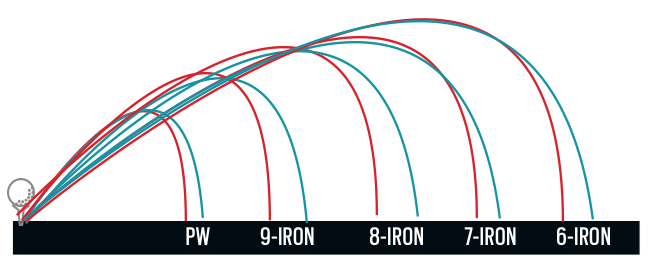
Will strong-lofted irons suit you?
As big a fan of strong-lofted irons as we are, they are not for everyone. If you’re the type of golfer who struggles to keep the ball in the air to maximise carry distance, your ball flight generally is low or you tend to hit weak, low-flying iron shots that end up right of the target, strong-lofted irons might well not be suited to your game.
In particular, low swing speed players might well be better suited to a set like new Cobra’s F-MAX which have weaker lofts to keep shots in the air for longer. If, though, you own a reasonable swing speed and generally flight shots quite high, and hit down on your irons rather than scoop them into the air, they can be a revelation.
If you try strong-lofted irons on a launch monitor, make sure you hit your own irons first. Pay close attention to the numbers, and try to ignore any gain in ball speed and carry distance and focus instead on checking that your backspin and launch angle numbers don’t drop significantly. Then compare shot height and descent angle into the green, as you don’t want these dropping dramatically against your own set, either, or you’ll hit shallow shots which won’t stop on a green.
These are our favourite 2018 strong lofted irons
Cobra King F8
7-iron loft: 29.5°
Ping G700
7-iron loft: 29.5°
TaylorMade M4
7-iron loft: 28.5°
Callaway Rogue X
7-iron loft: 27°
Mizuno JPX919 Hot Metal
7-iron loft: 30°
